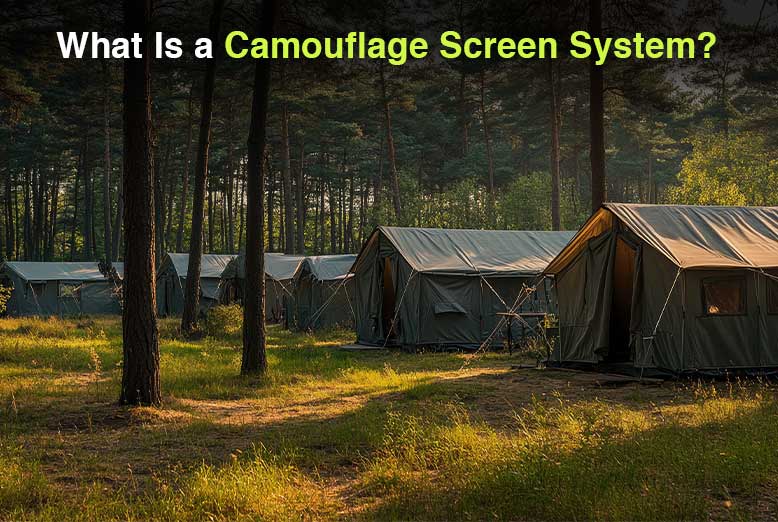Both military and civilian sectors seek innovative ways to blend into their environments. Whether for operational security or environmental considerations, camouflage screen systems provide a powerful solution. They aren’t just for hiding military assets or keeping installations secure; camouflage screens offer versatile applications across different industries. This article will explore what camouflage screen systems are, their benefits, and the unique applications that make them valuable across various fields.
Definition
A camouflage screen system is designed to conceal equipment, personnel, or structures by blending them into their surroundings. These systems are typically made from materials like fabric or netting that can mimic the colors, textures, and patterns of the surrounding environment. It aims to create a visual barrier that reduces visibility from the air or ground, especially in military contexts.
One example of a modern, highly advanced camouflage system is the Ultra-Lightweight Camouflage Net System (ULCANS). ULCANS technology enhances concealment by adapting to different terrains and environmental conditions, providing unmatched camouflage that works under various lighting and weather conditions. It can be used effectively in diverse environments, from deserts to forests to urban landscapes, ensuring that assets remain hidden when and where they need to be.
Benefits
Camouflage screens can be installed by military personnel, researchers, construction workers, and event planners, as modern systems are lightweight and designed for easy setup. Military-grade installations may require specialized training, but most commercial screens are simple enough for non-specialists to deploy with minimal guidance. Here are the advantages of installing camouflage screens:
1. Enhanced Operational Security
Camouflage screens provide a critical advantage by concealing valuable assets. In military applications, keeping equipment and personnel undetected is crucial for mission success. Units can avoid detection by adversaries, reducing the risk of preemptive strikes or unwanted attention. Civilian organizations, such as research stations or private entities, also benefit from keeping their installations concealed for security and operational reasons.
2. Versatile in Various Environments
Advanced camouflage systems, like ULCANS, are designed to adapt to different terrains. These structures come in a range of designs that mimic natural environments such as forests, snowfields, deserts, and more. Both military and non-military users can camouflage their setups in virtually any type of environment.
3. Reduced Environmental Impact
Camouflage systems reduce the visual footprint, which is especially useful in protected natural areas, where traditional constructions may be an eyesore. Camouflage screens are typically constructed from materials that don’t disturb the surrounding flora and fauna, making them ideal for field research or environmental protection projects.
4. Lightweight and Easy to Install
Camouflage screens are generally designed for quick and easy deployment. Their lightweight construction allows for easy transport, setup, and breakdown, which is valuable in remote or rapidly changing environments. Minimal training is required, allowing teams to deploy them as needed without significant delays.
Camouflage screens offer key advantages, from enhanced security to environmental preservation. Lightweight and easy to deploy, they provide an efficient solution for military, research, construction, and event needs alike.
Applications
Armed forces use these systems to keep equipment, vehicles, and personnel out of sight of enemy forces. ULCANS is a frequently deployed system, thanks to its adaptable materials that blend well in diverse settings. Camouflage screens provide the cover necessary to protect against enemy detection, allowing military units to maintain the element of surprise, conduct covert operations, or defend key assets without fear of detection. Check out the other military applications below.
1. Environmental Research and Conservation
Camouflage screens are becoming increasingly popular among environmental researchers. For those studying animal behavior in their natural habitats, camouflage screens provide a way to observe without disturbing. Similarly, these screens allow field researchers to set up temporary installations that do not disrupt the ecosystem visually or physically. Researchers can place monitoring devices, shelters, and small research stations under camouflage covers, helping to blend them into the natural environment while reducing the likelihood of interference from local wildlife.
2. Construction and Infrastructure Projects
Construction projects use camouflage screen systems to minimize the visual impact on surrounding areas. For example, in environmentally protected zones or tourist-heavy areas, construction sites might employ camouflage screens to maintain the natural look and feel of the landscape. The screens act as a visual barrier, reducing the eyesore effect of heavy machinery, scaffolding, and equipment. This is particularly relevant in urban areas where preserving aesthetic appeal is important for community relations.
3. Event and Film Production
For event organizers and filmmakers in the entertainment industry, camouflage screens can be used to blend equipment, staging areas, or sets into the surroundings seamlessly. Outdoor events like music festivals, wildlife documentaries, or nature-based filming projects benefit from the discrete placement of production equipment. It avoids visual distractions, enhancing the immersive experience for audiences while protecting expensive equipment from unnecessary attention.
Camouflage screens are versatile tools used across military, research, construction, and event fields. They provide essential concealment, protect sensitive equipment, and blend seamlessly into natural settings, enabling secure, discreet, and visually unobtrusive operations in any environment.
Final Thoughts
Camouflage screen systems provide a highly adaptable and beneficial solution across different industries. Initially designed for military applications, they have since proven their utility in fields like environmental research, construction, and media production.
Also Read: The Importance of Regular Health Screenings for Seniors




















